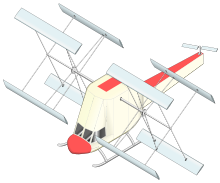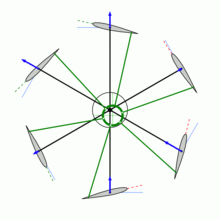- Cyclogyro
-
The cyclogyro, or cyclogyre, is an aircraft design that uses airfoils rotating around a horizontal axis for both lift and thrust. They are theoretically capable of vertical take off and landing and hovering performance like a helicopter, but do not suffer from the helicopter's problems in high-speed forward flight. Although a number of cyclogyros were built in the 1930s, none is known to have successfully flown. The cyclogyro could be mistaken for different aircraft designs using cylindrical wings, which attempted to harness the Magnus effect. However, these were unrelated aerodynamically and were equally unsuccessful.
Contents
Function
The cyclogyro wing resembles a paddle wheel, with airfoils replacing the paddles. The airfoils are individually adjustable in pitch, and are adjusted continually as they move around their axis. In normal forward flight the airfoils are given a slight positive pitch at the upper and forward portions of their arc, producing lift and forward thrust. They are given flat or negative pitch at the bottom, and are "flat" through the rest of the circle to produce little or no lift in other directions. The pitch can be adjusted to change the thrust profile, allowing the cyclogyro to travel in any direction.[1] Differential thrust between the two wings (one on either side of the fuselage) can be used to turn the aircraft around its vertical axis, although conventional tail surfaces are generally used as well.[2]
History
Jonathan Edward Caldwell appears to have been the first to patent the concept, and invent the term. He filed a patent on the concept that was granted in 1927, but immediately moved on to an ornithopter design and appears to have made no effort to build a cyclogyro of his own.[3] Several attempts to build a working cyclogyro were made by other designers. The earliest full-sized example appears to be the Schroeder S1 from 1930, which used the cyclogyro "wheels" for forward thrust only. Adolf Rohrbach of Germany designed a full VTOL version in 1933, which was later developed in the US and featured a tall fish-like fuselage to keep the wings well clear of the ground.[4] Another example is the Rahn Aircraft version from 1935, which used two much larger chord wings instead of a multi-blade wheel.[5]
In 1935 NACA carried out a series of wind tunnel experiments on the cyclogyro concept, and found that the power required to turn the wheels was much higher than expected.[2] Theoretical tools of the era simply weren't useful for prediction on the highly asymmetrical lift profiles and the greatly simplified models they used varied dramatically from real-world results. Early experiments then ended.
The concept has continued to periodically reappear from time to time since. One line of inquiry has been smaller UAV designs, where the hovering capability would be particularly useful.[6][7][8] These have been more successful, and at least one example has flown successfully, albeit tethered.
Modern uses
A team at the University of Singapore built a working model cyclogyro, although it has only flown in tethered flight to date. Their cycloidal model is a modified helicopter, with the rotor replaced with two sideways propellers, each with three blades sticking out of them in the perpendicular.[9] Subsequently Dr. Hu from the Singapore team moved to Northwestern Polytechnic University in China and there the team that he headed has built a free flying and precisely controlled Cyclogyro (Cyclocopter) which is a major development amounting to the beginning of the end for the Helicopters. Videos of its flights are readily findable on youtube: Test Flight of cyclogyro.flv Modern technology allows for many of the obstacles facing a 20th century cyclogyro developer to be easily overcome. Rapid and precise changes to the "wing" configuration can be accomplished by microprocessors, materials are lighter and can be more precisely adapted to the needs at hand, et cetera.
The Austrian company Innovative Aerodynamic Technologies (IAT) premiered a 4 rotor cyclogyro at the Paris Air Show in June 2011. IAT has christened their creation Project D-DALUS. The company's website describes the prototype as follows:
"The propulsion consists of 4 sets of contra-rotating disks, each set driven at the same rpm by a conventional aero-engine. The disks are surrounded by blades whose angle of attack can be altered by off-setting the axis of the rotating disks. As each blade can be given a different angle of attack, the resulting main thrust can be in any required direction in 360° around any axis. This allows the craft to launch vertically, remain in a fixed position in the air, travel in any direction, rotate in any direction, and thrust upwards thereby ‘gluing down’ on landing."[10]
References
- ^ The Development of cyclogyro
- ^ a b The Cyclogyros, Planned paddle-wheel aeroplanes
- ^ The Fantastically Flighty Gray Goose
- ^ Rohrbach Cyclogyro
- ^ http://www.aerofiles.com/_ra.html Aerofiles, subsection Rahn: single-seat, 240 hp supercharged Wright Whirlwind, two six-foot rotating wings on each side, 15 foot length. US registration NX 13247; no evidence of successful flight
- ^ Aerodynamics of the Cyclogyro
- ^ The research on the performance of cyclogyro
- ^ Development of a Cyclogyro-based Flying Robot with Variable Attack Angle Mechanisms
- ^ Simonite, Tom (2008-02-22). "Flying 'paddleboat' may finally take off". NewScientist.com news service. http://technology.newscientist.com/channel/tech/dn13368-flying-paddleboat-may-finally-take-off.html?feedId=online-news_rss20.
- ^ IAT (2011-07-08). "IAT Company Website". http://iat21.at/. http://start.d-dalus.at/?feedId=online-news_rss20.
Further reading
- "The Cyclogyro", Vertiflight, The American Helicopter Society, 2005, Vol. 51; No. 2, pages 16-19
External links
Categories:
Wikimedia Foundation. 2010.


